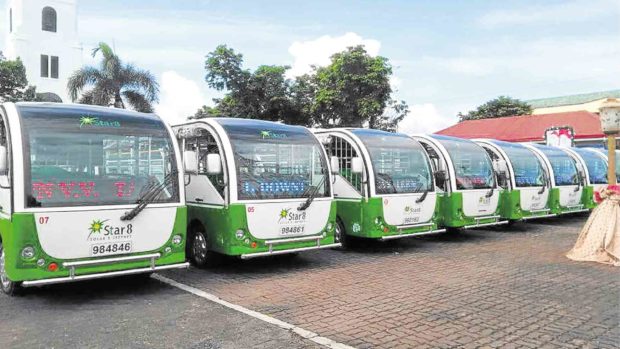
MODERN FLEET Solar-powered jeepneys will take people living in resettlement sites in Tacloban City to their places of work or schools. — CONTRIBUTED PHOTO
TACLOBAN CITY—Arlene Petilla, 44, has heaved a sigh of relief.
After living for more than a year in a relocation site, passenger jeepneys have finally started servicing her and other residents at North Hill Arbours in Barangay Santo Niño here.
These are no ordinary public utility vehicles (PUV); these run on solar energy.
At least 45 units of electronic jeepneys (e-jeepneys) have provided transportation to more than 9,000 families now living in resettlement sites in this city devastated by Supertyphoon “Yolanda” (international name: Haiyan) in 2013.
The operation of these PUVs, part of the public transportation modernization plan of the government through the Department of Transportation, was launched in this city on Tuesday.
Speaking on behalf of Tacloban City Mayor Cristina Romualdez, chief legal officer Antoinette Kaye Barreda said the solar-powered vehicles would help families living in 11 resettlement sites in northern Tacloban, who had been complaining about the lack of transportation services in their areas.
These families were mostly from San Jose and Sagkahan districts, whose houses were destroyed when the city was pummeled by Yolanda.
Waiting for hours
“We had to wait for hours and fall in line at waiting stations which sometimes was the reason why we would report late for work or school,” Petilla said.
Petilla works at the town of Palo, some 24 kilometers away from the relocation site. Her daughter, Renalyn, is a Grade 12 student at the Leyte National High School in Tacloban City center, which is 13 km from their home.
Martin Delgra III, chair of the Land Transportation Franchising and Regulatory Board, said families in resettlement areas would benefit from the three “missionary routes” the agency had opened.
Prior to this initiative, Delgra said the local government provided six buses for free to residents. However, each bus would take only a single trip daily, and residents have to wait for two hours to catch a ride.
With the 45 e-jeepneys, not only will the trips become more frequent but these are expected to be safer since the units are equipped with dashboard and closed circuit television cameras. Drivers can also focus more as the units are equipped with an automatic fare collection system.
Each vehicle is equipped with a television set and WiFi and can accommodate 20 passengers. Passengers can also charge their mobile phones while traveling.
Modernization
Delgra said the deployment of these vehicles was part of the modernization program being introduced by the Duterte administration in the public transportation sector.
William Rael, 47, one of the e-jeepney drivers, finds his work “easy and comfortable.”
“We also attended a seminar on proper driving. We were asked to drive slowly, at most 60 km per hour, to avoid accidents,” Rael said, who also lives in the northern village of Basper.
He said drivers were paid P500 a day while a “marshal” or collector got P280 a day.
The e-jeepneys in Tacloban is run and operated by Star 8 Green Technology Corp. based in Las Piñas City.
Franchise
Delgra, however, said local operators were welcome to apply for franchise using the same vehicles.
He said the government was implementing a “one route, one franchise” policy for Tacloban, which would also be used as a template in the rollout of the modernization program in other cities and towns. Each of the three routes in Tacloban would have 15 e-jeepneys.
Fares for these routes will follow the regular jeepney fare in Eastern Visayas—from the minimum P7 to P20 for the farthest route. Students, persons with disabilities and the elderly will be given fare discounts. —WITH REPORTS FROM JOVIC YEE IN MANILA

